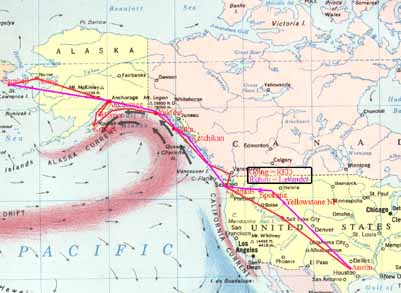used was a Kodak Digital DC210 plus. Click on the underlined choice to view the corresponding picture. Then use the back button on your browser to return to this page for further viewing.

The captions below reference pictures taken on a trip during May-June,
1999 by Benjamin and Joanne Trimble in a Mooney Executive 21 airplane.
The camera
used was a Kodak Digital DC210 plus. Click on the underlined
choice to view the corresponding picture. Then use the back button on
your browser to return to this page for further viewing.

We pass Mt. St Helens in Washington State enroute.
The giant Pacific Oyster (sans shell) provides a delicious feast during a stopover in Chehalis, Washington.
Delayed by incessant rain, we lay over in the rain capital of Alaska -- Yakutat. Note the snow pile still present on the runway apron.
The Yakutat lodge entrance bids us welcome with an intimidating display: a Big Brown Bear (aka Grizzly Bear).
Next, a visit to Kodiak and the native museum provides a glimpse into the classical techniques of the eskimo hunter.
In Anchorage, we rent a car and drive the Denali Highway, where an incredible view of Mt. McKinley unfolds.
We are surprised by a persistent attempt by a young reindeer (caribou) to outrun the car.
Alaska is a land of glaciers and here we capture a dynamic landscape which is dominated by a large glacier.
Homer Alaska is a picturesque artistic and fishing community. Shops line the 5-mile long spit which extends out into Kachemak Bay.
The rocky outcrops in Kachemak Bay are the home to thousands of nesting sea birds, including Kittiwake gulls and Red-faced Cormorants.
Returning to Anchorage, we camp along the Russian River, one of the best fishing spots in Alaska.
Next we fly from Anchorage to the old gold mining town of Nome, finishing point for the Iditarod dog sled race. On main street, the Nugget Inn provides signs to orient the traveler: Moscow 4400 miles, Dallas 4600 miles.
Three roads lead from Nome: along the eastern highway, Joanne poses beside a huge snow bank.
Along the eastern road out of Nome, an old steam engine survives from the war years: the "last train to nowhere".
Next, we cross 100 miles of the Bering Sea to land in Gambell, St. Lawrence, Alaska where four young Yupik eskimo men meet the plane.
The eskimo community of Gambell has a "subsistence lifestyle" which is heavily dependent on hunting. Here seal carcasses from the hunt are stored for later use.
The polar bear is hunted for its skin and meat. A skin hangs out to dry.
Anders Passingok, a retired school teacher guided us around the Gambell area in search of interesting birds. His adopted daughter Melinda smiles for the camera.
Here, we pose on the edge of a large fresh water lagoon south of Gambell, a good spot to find rare birds.
The pack ice has now broken into large chunks and is swept along the very western-most tip of St. Lawrence Island. Forty miles straight accross this stretch of water looms Siberia and "Mother Russia".
Ben poses beside a large rib bone from the remains of a large whale.
On the trip from Gambell to Anchorage in the airplane, we cross the Alaska Range with Mt. McKinley clearly visible on the horizon.
On our way south, we pass through the Alaska panhandle and the old Russian capital of Sitka. The harbor area of Sitka provides a picturesque backdrop to this quaint town.
The New Archangel Dancers perform a repertoire of Russian folk dances for visitors to Sitka.
The Cathedral of St. Michael the Archangel towers over the center of town as a reminder of the Russian history of Sitka.
A native totem pole graces the harbor area and beckons guests to visit the native heritage center.
Sitka: sunset
and a clearing sky.
Looking into a hot boiling cauldron of sulfurous liquid.
Buffalo migrate to a new grazing area (note the young calves).
We move in close to three indifferent buffalo.
The grand canyon of the Yellowstone: roaring falls and ochre colored canyon walls.
The Mammoth Hot Springs is decked with a myriad of colorful thermal pools.
The ever-changing landscape of thermal activity: trees are engulfed as new areas are formed.
Old Faithful hasn't changed in the 30 years since we last visited.
South of Yellowstone, the Grand Tetons provide
a fitting backdrop for our final day.